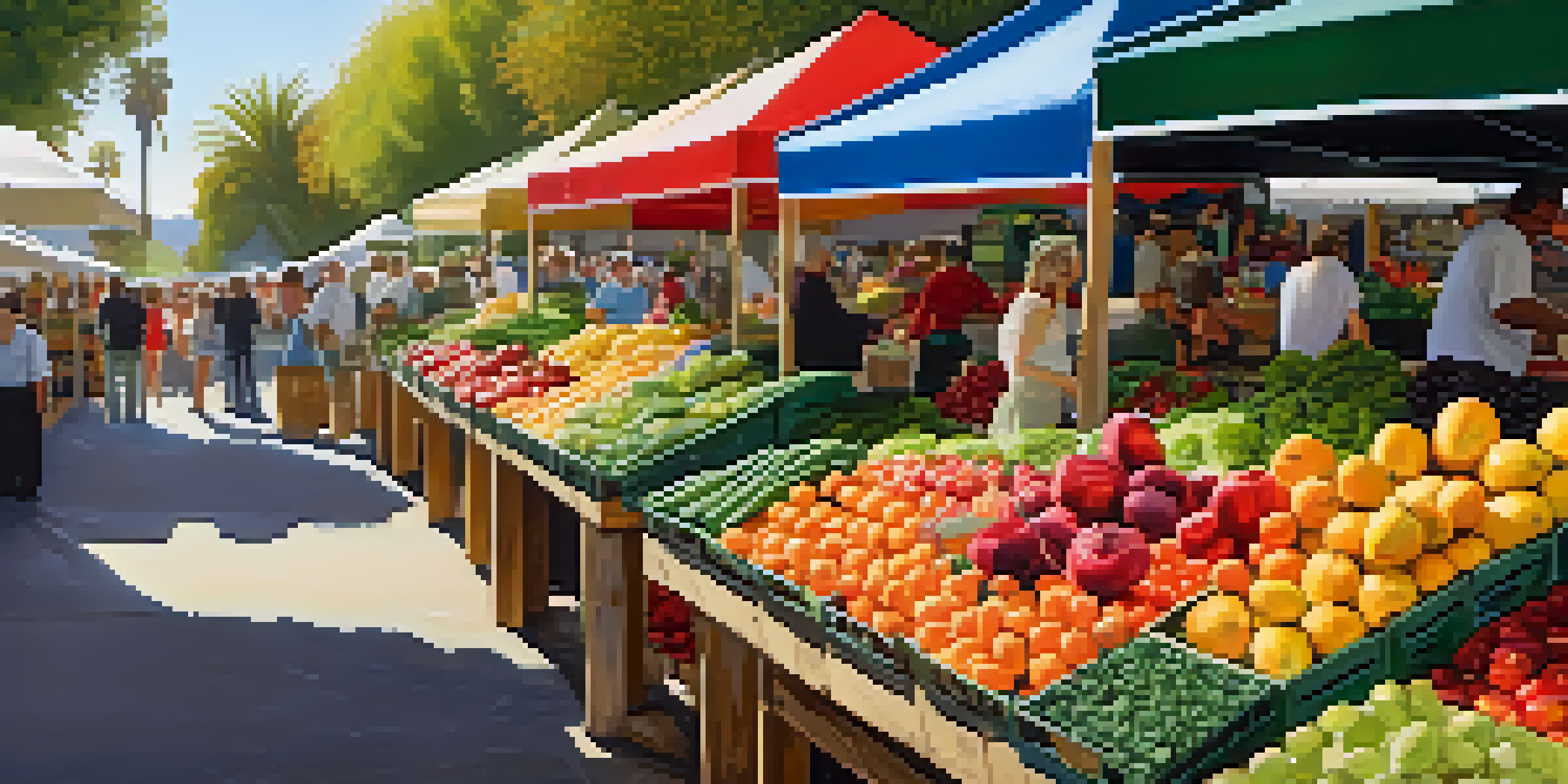Exploring California's Farm-to-Table Movement in Depth

Understanding the Farm-to-Table Concept
The farm-to-table movement emphasizes the connection between food producers and consumers, focusing on local sourcing. This concept promotes the idea that food should travel the shortest distance possible from the farm to your plate, ensuring freshness and flavor. By prioritizing local ingredients, restaurants and chefs can support nearby farmers while also crafting seasonal menus that reflect the region's bounty.
The farm-to-table movement is not just about food; it's about connecting with the land and the community that produces it.
In California, this movement has gained tremendous momentum, with many chefs adopting the philosophy as a core part of their culinary practices. You can often find dishes featuring locally sourced produce, meats, and dairy that truly showcase the essence of California's diverse agriculture. This not only enhances the dining experience but also fosters a deeper appreciation for the work that goes into food production.
Furthermore, the farm-to-table approach often aligns with sustainable practices, encouraging environmentally friendly farming methods. This means that when you choose farm-to-table options, you're not just enjoying delicious food; you're also supporting a healthier planet.
California's Agricultural Landscape: A Rich Tapestry
California boasts a diverse agricultural landscape, making it a prime location for the farm-to-table movement. From the sun-kissed vineyards of Napa Valley to the fertile valleys of the Central Coast, the state's various climates enable a wide range of crops to thrive. This diversity not only enriches the local economy but also provides chefs with an abundance of fresh, high-quality ingredients to work with.

The state's agricultural output is staggering, producing nearly half of the fruits, vegetables, and nuts grown in the United States. This means that when you dine at a California restaurant, you're likely enjoying ingredients that were harvested just hours earlier. Such freshness is a key component of the farm-to-table experience, enhancing flavors and nutritional value.
Farm-to-Table Enhances Freshness
The farm-to-table movement ensures food travels the shortest distance from farm to plate, promoting freshness and supporting local farmers.
Moreover, California's commitment to sustainable farming practices has made it a leader in organic agriculture. Many farms prioritize eco-friendly methods, ensuring that the food served on your plate is produced with care for both the environment and the consumer's health.
The Role of Local Farmers and Artisans
Local farmers and artisans play a crucial role in the farm-to-table movement, serving as the backbone of this culinary philosophy. By building relationships with these producers, chefs can gain access to unique, high-quality ingredients that set their menus apart. Farmers often share their stories and practices, allowing chefs to create dishes that honor the land and the labor behind the food.
Eating locally is not just a trend; it’s a way of life that nurtures our bodies and our communities.
Farmers' markets are a vibrant part of this ecosystem, providing a direct channel for consumers to connect with local producers. Visiting a farmers' market not only supports the local economy but also allows you to learn about the season's best offerings. You might even discover new ingredients that inspire your own cooking at home.
Additionally, collaborations between chefs and local artisans, such as cheesemakers and bakers, further enrich the farm-to-table experience. These partnerships highlight the craftsmanship involved in food production, creating a narrative that enhances the overall dining experience.
The Impact of Farm-to-Table on Dining Culture
The farm-to-table movement has significantly influenced California's dining culture, shifting consumer expectations and preferences. Diners are increasingly seeking transparency regarding where their food comes from, pushing restaurants to highlight local sourcing on their menus. This trend has led to a greater appreciation for seasonal eating, encouraging people to explore new flavors and dishes throughout the year.
Restaurants embracing the farm-to-table philosophy often feature rotating menus that change with the seasons. This not only keeps the dining experience fresh and exciting but also allows chefs to showcase the best ingredients available at any given time. As a result, patrons can enjoy meals that reflect California's agricultural cycles and unique regional flavors.
California's Diverse Agriculture
California's varied climates cultivate a rich array of crops, providing chefs with high-quality, seasonal ingredients for their menus.
Moreover, the farm-to-table movement has fostered a sense of community among diners, farmers, and chefs. People are more inclined to support local businesses and engage in conversations about food, sustainability, and health, creating a more connected and informed dining scene.
Challenges Facing the Farm-to-Table Movement
While the farm-to-table movement has many advantages, it also faces several challenges that can hinder its growth. One significant issue is the accessibility of local ingredients, especially for restaurants located in urban areas where space and resources may be limited. Chefs often struggle to find enough local suppliers to meet their demands, which can lead to a reliance on larger distributors.
Additionally, the rising costs associated with local sourcing can be a barrier for many restaurants. Farmers' prices can fluctuate based on seasonal yields, and this unpredictability can make it difficult for chefs to maintain consistent menu pricing. As a result, some establishments may opt for cheaper, non-local ingredients to keep their costs manageable.
Lastly, consumer education plays a crucial role in supporting the farm-to-table movement. Many diners may not fully understand the benefits of choosing local ingredients or may prioritize convenience over quality. Raising awareness about the importance of local food systems is essential for fostering a more sustainable dining culture.
Celebrating Farm-to-Table Events and Festivals
California hosts a variety of events and festivals that celebrate the farm-to-table movement, bringing together food lovers, chefs, and farmers in a vibrant showcase of local cuisine. Events such as the California Farmers' Market Association's annual market showcase and various farm dinners highlight the incredible bounty of the state's agriculture. These gatherings provide an opportunity for attendees to taste seasonal offerings while learning about the farmers and producers behind their food.
One popular event is the 'Farm-to-Fork' festival, which highlights the importance of local sourcing and showcases the talents of local chefs. At these festivals, you can often participate in cooking demonstrations, tastings, and even farm tours, deepening your understanding of the farm-to-table philosophy. It's a fun way to engage with the community and appreciate the hard work that goes into producing the food we enjoy.
Community Focus in Dining Culture
This movement fosters a sense of community among diners, farmers, and chefs, encouraging conversations about sustainability and local food systems.
These events not only promote local agriculture but also inspire a sense of pride in California's food culture. They encourage collaboration between chefs and farmers, helping to strengthen the bonds within the community and further the farm-to-table movement.
The Future of the Farm-to-Table Movement in California
As the farm-to-table movement continues to evolve, its future in California looks promising. Increasing awareness about food sustainability and health-conscious eating habits among consumers is driving demand for locally sourced ingredients. This shift in consumer behavior is likely to encourage more restaurants to adopt farm-to-table practices, resulting in a wider variety of dining options for patrons.
Additionally, advances in technology and transportation logistics are making it easier for chefs to access local produce, even in urban areas. Innovations such as mobile apps connecting restaurants with nearby farms or community-supported agriculture (CSA) programs help bridge the gap between producers and consumers. This increased accessibility will only bolster the growth of the movement.

Ultimately, the farm-to-table movement embodies a broader shift towards sustainability and community engagement in the culinary world. As more individuals recognize the value of supporting local food systems, the movement will likely continue to thrive, enriching California's food culture for generations to come.